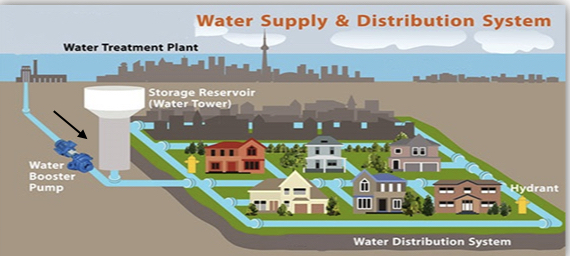Here are 4 sample questions for the Water Operator Certification Test. These questions are relevant for both Water Distribution and Water Treatment Operator Certification Exam.
The answers are located below, near the end of the page.
For more practice problems:
Water Distribution Operator Certification Test – Practice Problems
Water Treatment Operator Certification Test- Practice Problems
- What is the minimum chlorine residual concentration required at the entrance of a water distribution system?
-
-
- 1 mg/L
- 2 mg/L
- 0.5 mg/L
- 0.2 mg/L
-
2. What problem could arise if the pH of the water is low?
-
-
- Excessive THM
- Scaling
- Hardness
- Corrosion
-
3. ____________ is the maximum advisable rate of chlorine removal from a 150-lb gas cylinder.
-
-
- 20 pounds per day
- 30 pounds per day
- 40 pounds per day
- 50 pounds per day
-
4. What is one of the requirements if a routine water sample tests positive for total coliform bacteria?
-
-
- Test for viruses
- Check for Giardia
- Test for E. coli
- Test for Cryptosporidium
-
Answers:
-
D
The chlorine concentration at the entrance to a water distribution system must be at least 0.2 mg/L. The entrance to a water distribution system is where water flows out of a water treatment plant.
A minimum chlorine concentration is required to ensure there is chlorine residual throughout the water distribution system. Without chlorine residual, it would be unsafe for the water supply. For example, a lack of chlorine residual could lead to an outbreak of waterborne disease.
Therefore, a minimum chlorine concentration of 0.2 mg/L is required at the entrance to a water distribution system.

2. D
A water supply with low pH could cause corrosion of metallic pipes and facilities. Corrosion means “rusting of metallic surfaces.”
The lower the pH, the more corrosive the water. Therefore, you want to prevent the water supply from having low pH.
One of the ways to prevent corrosion in a water distribution system is to control the pH of water. By doing so, you can ensure the pH is not too low, and protect the water facilities from rusting.
Low pH is essentially acidic water. The lower the pH, the more acidic the water. For example, a pH of 1 is extremely acidic. You would never see a water supply with a pH that low. A pH of 7 is considered neutral, while a pH of 14 is a very strong base.
Make sure you understand the following pH scale before you take your water operator certification test:

3. C
The maximum advisable withdrawal rate of chlorine from a 150-lb gas cylinder is 40 pounds per day. If the withdrawal rate is higher than 40 pounds per day, the cylinder will frost. Therefore, you don’t want to withdraw chlorine at a higher rate. Make sure to keep it no more than 40 pounds per day.
My recommendation is to study all aspects of disinfection for the water operator certification test. In addition to chlorine gas, it’s important to understand the basics of chloramine, sodium hypochlorite, and calcium hypochlorite.
4. C
If a routine water sample tests positive for total coliform bacteria, one of the requirements is to test the sample for E.coli. This requirement is part of the Revised Total Coliform Rule.
Additionally, if a sample tests positive for total coliform bacteria, three repeat samples must be collected. One of the repeat samples must be taken from the same tap as the original sample, while the other two must be taken within 5 services upstream, and within 5 services downstream of the original tap.
Lastly, make sure to learn the basic requirements of sampling. At first, it may seem confusing, but it’ll become crystal-clear over time. It’s an important topic for the water operator certification test.
HELPFUL RESOURCES:
Water Distribution Operator Certification Exam – Practice Problems
Water Treatment Operator Certification Exam – Practice Problems
Tips for passing your exam
One of the best ways to study for the water operator certification test is to solve a lot of practice questions. It’s a great way to test your knowledge and identify your weaknesses. I’ve used it throughout my life, and had excellent results. If you’re looking for more practice questions or sample problems, go to the following link: practice problems.




Pingback: Water Distribution Operator - Practice Test for Certification
Pingback: Water Treatment Certification Practice Test - For Operator Exam